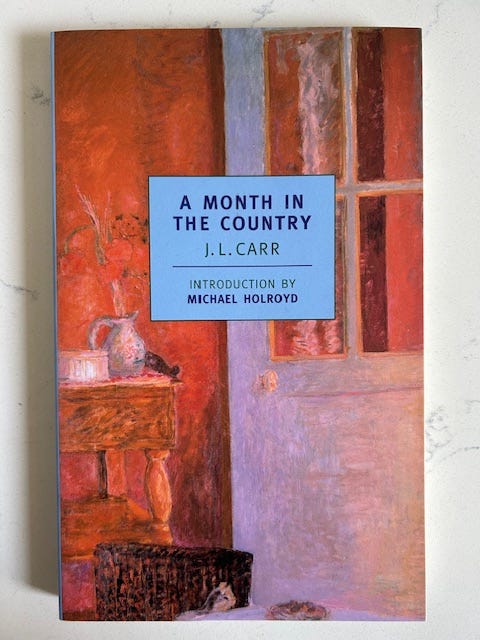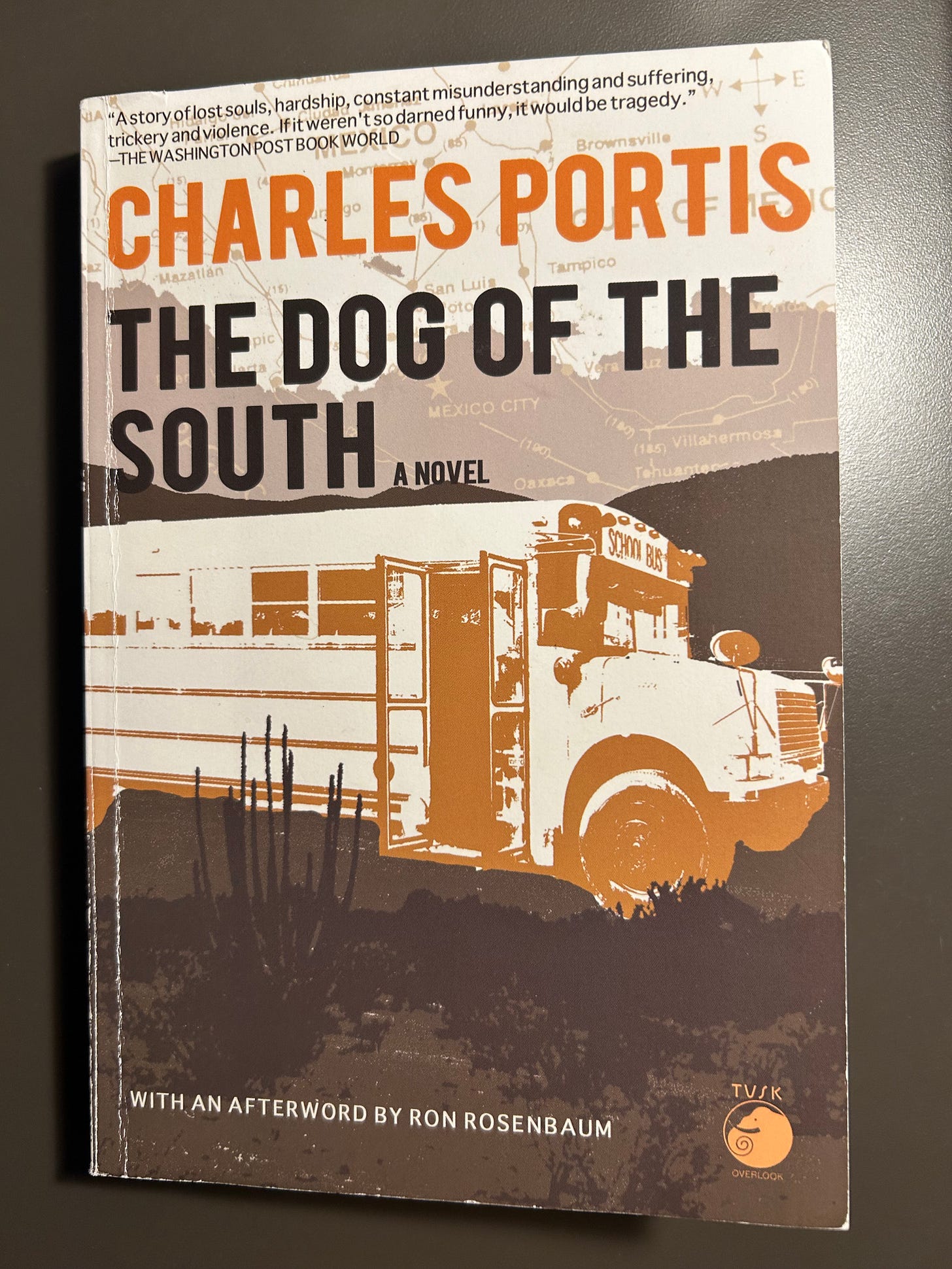'A Month in the Country' by J. L. Carr
The restorative powers of art and community animate this novel that's perfect for short-book summer.—Review #234

Last time we spoke, we established that Books on GIF is having a short-book summer. But a few of you reached out to say you were embarking on a long-book summer instead. In my view, whichever book-sized summer you plan to have is correct. Read what you want! Short books, long books, in-between, it’s all good. The point is to enjoy books! But I’m keeping my short-book summer rolling this week with a novel that Mel on Twitter described as the perfect book for such a thing: ‘A Month in the Country’ by J. L. Carr. Mel is not wrong!
Here’s the cover:

Tom Birkin, a World War I veteran and newly minted art restorer, leaves London for a commission in northern England to uncover a church’s medieval mural that had been whitewashed centuries ago. We meet Birkin as his train pulls into Oxgodby, the rural town where the story unfolds in summertime 1920. He’s in rough shape: PTSD from the war has left him with a facial twitch, his wife has run off with another man, and he is getting soaked by the rain on his walk from the train station to the church. Once at the church, he meets the local vicar, Rev. Keach, who thinks Birkin’s project is a waste of time because, once uncovered, the wall painting will distract churchgoers from their prayers. Perhaps he thought it would depict something like:

Birkin’s job, funded by a bequest from a local woman who recently died, pays very little, and, since no one will take him in (not even the clergyman who lives in a mansion with many empty rooms), he has to sleep in the belfry. Looking out the window of his elevated quarters he sees a tent in a nearby field. It’s inhabited by an archaeologist named Moon, also a war veteran, who’s dug a foxhole inside his shelter. Moon has been commissioned by the same woman’s estate to find the grave of one of her ancestors who, for unknown reasons, was buried off sacred grounds outside the church’s graveyard. But Moon has his own private mission, too, to uncover some ancient Anglo-Saxon something-or-other and dreams of getting hired at a bigger archaeological dig:

As Birkin works, local children come to the church and play music for him on a record player. He is also visited by the vicar’s wife, the beautiful and warm-hearted Alice Keach, and he starts to fall in love with her. While he slowly reveals the wall painting, Birkin learns details about the anonymous medieval artist—the color of his hair from bits stuck in the paint, the tragic reasons behind certain details in the picture. Birkin eventually discovers he’s uncovering a masterpiece. Over several weeks, as he communes with the artwork and with the people of Oxgodby, his twitch abates, his mood eases. The project has helped him start to heal. I watched the 1987 film adaptation staring an extremely young Colin Firth as Birkin (and Kenneth Branagh as Moon and Natasha Richardson as Alice), and it’s fine. But I really loved this moment as the painting starts to stir Birkin’s soul:
Eventually, we learn that Birkin is narrating this story looking back on it after many decades. We also learn that Moon is processing his own war trauma, one that involves a secret that Birkin inadvertently learns. And both men realize that their respective projects are surprisingly interconnected. I will say no more about this.

I first heard about ‘A Month in the Country’ from this Instagram post by Tom Ayling, where he said it is one of his favorite books. When I bought the novel, which was a finalist for the 1980 Booker Prize, from Lofty Pigeon Books, one of the shop’s owners told me it was great. After I posted on social media that I was reading the book, several folks pinged me to say how much they loved it, too. I now add my name to that list. This is an achingly beautiful book. I love how it demonstrates the power of art, friendship and community to heal and uplift us. I love how it shows the joy and satisfaction that can come from complete absorption in creative work. I love how it captures an experience all of us have had, when summers like this—with fleeting yet profound moments—get locked in the amber of our memories. I love how it wistfully contemplates the paths taken—toward romance, toward a new life—and those not taken. And I absolutely lost it when Birkin takes a rose given to him by Alice and presses it into a book, knowing someday someone will discover it in a second-hand shop and wonder. That had me like:

‘A Month in the Country’ is wonderful, and you all should read it. I flew through it, and it made me want to change careers to become an art restorer (how does one become an art restorer?). It’s a perfect summer novel, whether you’re doing short-book summer or not.
An opening excerpt:
When the train stopped I stumbled out, nudging and kicking the kitbag before me. Back down the platform someone was calling despairingly, “Oxgodby … Oxgodby.” No-one offered a hand, so I climbed back into the compartment, stumbling over ankles and feet to get at the fish-bass (on the rack) and my folding camp-bed (under the seat). If this was a fair sample of northerners, then this was enemy country so I wasn’t too careful where I put my boots. I heard one chap draw his breath and another grunt: neither spoke.
Then the guard whistled, the train jerked forward a couple of paces—and stopped. This was enough to goad the old man in the nearside corner to half-lower his window. “Thoo’s ga-ing ti git rare an’ soaaked reet doon ti thi skin, maister,” he said and shut the window in my face. Then the engine blew up a splendid plume of steam and shuffled off, a row of faces staring woodenly at me. And I was alone on the platform, arranging my pack, taking a last look at a map, pushing it into my topcoat pocket, levering it out again to spill my ticket on the stationmaster’s boots, wishing I’d sewn on two missing buttons, hoping that it would stop raining until I had a roof over my head.
A youngish girl, her face flattened against a window-pane, started at me from the stationmaster’s house. It must have been my coat which interested her; it was pre-War, about 1907 I should imagine, wonderful material, the real stuff, thick herring-bone tweed. It reached down to my ankles; its original owner must have been a well-to-do giant.
My rating:

‘A Month in the Country’ by J. L. Carr was published by Harvester in 1980 and by the New York Review of Books in 2000. 135 pages. $14.83 at Bookshop.org.
What’s next:
Books on GIF does not solicit review copies. We feature books we purchase at independent bookstores around New York City and on our travels, or were borrowed electronically from the Brooklyn Public Library.
Before you go:
ICYMI: Review #233
Read this: Big things are happening at Womb House Books, my favorite Etsy-based book store. It just launched a newsletter, and the first edition includes an interview with author Sheila Heti. I’m looking forward to reading it, as well as visiting Womb House’s recently opened brick-and-mortar bookstore in Oakland, Calif. There are several reasons why I need to get back to the Bay Area, and now I’ve got another one!
If you enjoyed this review:
Thanks for reading, and thanks especially to Donna for editing this newsletter!
Until next time,

MPV









So glad you loved it as much as I did! Excellent review and homemade GIF. Stay cool and hi to Donna!!
I have yet to read an NYRB Classic that hasn't stunned me, in the best way. I usually avoid books about war-related PTSD -- it just hits too close to home for me -- but I'll be picking this one up ASAP.